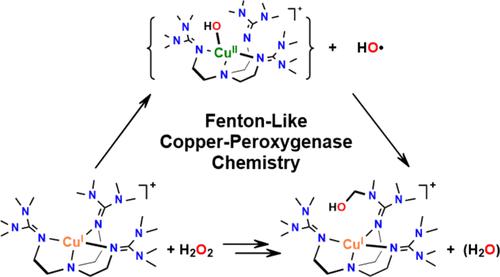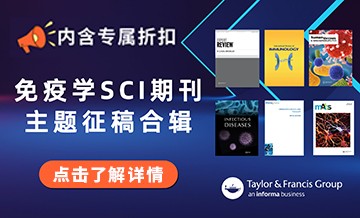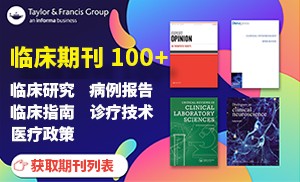当前位置:
X-MOL 学术
›
J. Am. Chem. Soc.
›
论文详情
Our official English website, www.x-mol.net, welcomes your
feedback! (Note: you will need to create a separate account there.)
Fenton-like Chemistry by a Copper(I) Complex and H2O2 Relevant to Enzyme Peroxygenase C–H Hydroxylation
Journal of the American Chemical Society ( IF 14.4 ) Pub Date : 2023-05-17 , DOI: 10.1021/jacs.3c02273
Bohee Kim 1 , Magdalene T Brueggemeyer 2 , Wesley J Transue 2 , Younwoo Park 3 , Jaeheung Cho 4 , Maxime A Siegler 1 , Edward I Solomon 2 , Kenneth D Karlin 1
Journal of the American Chemical Society ( IF 14.4 ) Pub Date : 2023-05-17 , DOI: 10.1021/jacs.3c02273
Bohee Kim 1 , Magdalene T Brueggemeyer 2 , Wesley J Transue 2 , Younwoo Park 3 , Jaeheung Cho 4 , Maxime A Siegler 1 , Edward I Solomon 2 , Kenneth D Karlin 1
Affiliation

|
Lytic polysaccharide monooxygenases have received significant attention as catalytic convertors of biomass to biofuel. Recent studies suggest that its peroxygenase activity (i.e., using H2O2 as an oxidant) is more important than its monooxygenase functionality. Here, we describe new insights into peroxygenase activity, with a copper(I) complex reacting with H2O2 leading to site-specific ligand–substrate C–H hydroxylation. [CuI(TMG3tren)]+ (1) (TMG3tren = 1,1,1-Tris{2-[N2-(1,1,3,3-tetramethylguanidino)]ethyl}amine) and a dry source of hydrogen peroxide, (o-Tol3P═O·H2O2)2 react in the stoichiometry, [CuI(TMG3tren)]+ + H2O2 → [CuI(TMG3tren-OH)]+ + H2O, wherein a ligand N-methyl group undergoes hydroxylation giving TMG3tren-OH. Furthermore, Fenton-type chemistry (CuI + H2O2 → CuII-OH + ·OH) is displayed, in which (i) a Cu(II)-OH complex could be detected during the reaction and it could be separately isolated and characterized crystallographically and (ii) hydroxyl radical (·OH) scavengers either quenched the ligand hydroxylation reaction and/or (iii) captured the ·OH produced.
中文翻译:

与酶过氧合酶 C-H 羟基化相关的铜 (I) 络合物和 H2O2 的类芬顿化学
裂解多糖单加氧酶作为生物质转化为生物燃料的催化转化器受到了极大的关注。最近的研究表明,其过氧化酶活性(即使用H 2 O 2作为氧化剂)比其单氧化酶功能更重要。在这里,我们描述了对过氧化酶活性的新见解,铜(I)络合物与 H 2 O 2反应导致位点特异性配体-底物 C-H 羟基化。[Cu I (TMG 3 tren)] + ( 1 ) (TMG 3 tren = 1,1,1-Tris{2-[ N 2 -(1,1,3,3-四甲基胍)]乙基}胺) 和过氧化氢的干源,( o -Tol 3 P=O·H 2 O 2 ) 2按化学计量反应,[Cu I (TMG 3 tren)] + + H 2 O 2 → [Cu I (TMG 3 tren-) OH)] + + H 2 O,其中配体N-甲基发生羟基化,得到TMG 3 tren-OH。此外,还显示了芬顿型化学(Cu I + H 2 O 2 → Cu II -OH + ·OH),其中(i)在反应过程中可以检测到 Cu(II)-OH 络合物,并且可以将其单独分离出来。分离并进行晶体学表征,(ii) 羟基自由基 (·OH) 清除剂猝灭配体羟基化反应和/或 (iii) 捕获产生的·OH。
更新日期:2023-05-17
中文翻译:

与酶过氧合酶 C-H 羟基化相关的铜 (I) 络合物和 H2O2 的类芬顿化学
裂解多糖单加氧酶作为生物质转化为生物燃料的催化转化器受到了极大的关注。最近的研究表明,其过氧化酶活性(即使用H 2 O 2作为氧化剂)比其单氧化酶功能更重要。在这里,我们描述了对过氧化酶活性的新见解,铜(I)络合物与 H 2 O 2反应导致位点特异性配体-底物 C-H 羟基化。[Cu I (TMG 3 tren)] + ( 1 ) (TMG 3 tren = 1,1,1-Tris{2-[ N 2 -(1,1,3,3-四甲基胍)]乙基}胺) 和过氧化氢的干源,( o -Tol 3 P=O·H 2 O 2 ) 2按化学计量反应,[Cu I (TMG 3 tren)] + + H 2 O 2 → [Cu I (TMG 3 tren-) OH)] + + H 2 O,其中配体N-甲基发生羟基化,得到TMG 3 tren-OH。此外,还显示了芬顿型化学(Cu I + H 2 O 2 → Cu II -OH + ·OH),其中(i)在反应过程中可以检测到 Cu(II)-OH 络合物,并且可以将其单独分离出来。分离并进行晶体学表征,(ii) 羟基自由基 (·OH) 清除剂猝灭配体羟基化反应和/或 (iii) 捕获产生的·OH。







































 京公网安备 11010802027423号
京公网安备 11010802027423号